Audit, Assurance, and Compliance Report: TWE and ASX Principles
VerifiedAdded on 2021/06/14
|20
|3220
|19
Report
AI Summary
This report provides a comprehensive analysis of the audit, assurance, and compliance practices of Treasury Wine Estates (TWE), focusing on its adherence to the ASX Corporate Governance Council (CGC) principles. The report begins with an introduction to auditing and the importance of corporate governance, followed by an examination of TWE's compliance with each of the seven ASX CGC principles. It assesses TWE's risk management strategies, including its approach to risk assessment, the nature and market overview of the wine industry, regulatory compliance, and the identification of relevant business and financial risks. The report includes financial ratio analysis (profitability, liquidity, efficiency, and solvency) to evaluate TWE's financial performance. Furthermore, it identifies key risks such as currency fluctuations, competitive pressures, and climate change, along with potential steps to mitigate these risks. The report concludes with a summary of findings and recommendations, emphasizing the importance of robust corporate governance and effective risk management in the wine industry. The report highlights the importance of maintaining financial integrity, timely disclosure, and shareholder rights within the context of the ASX guidelines.
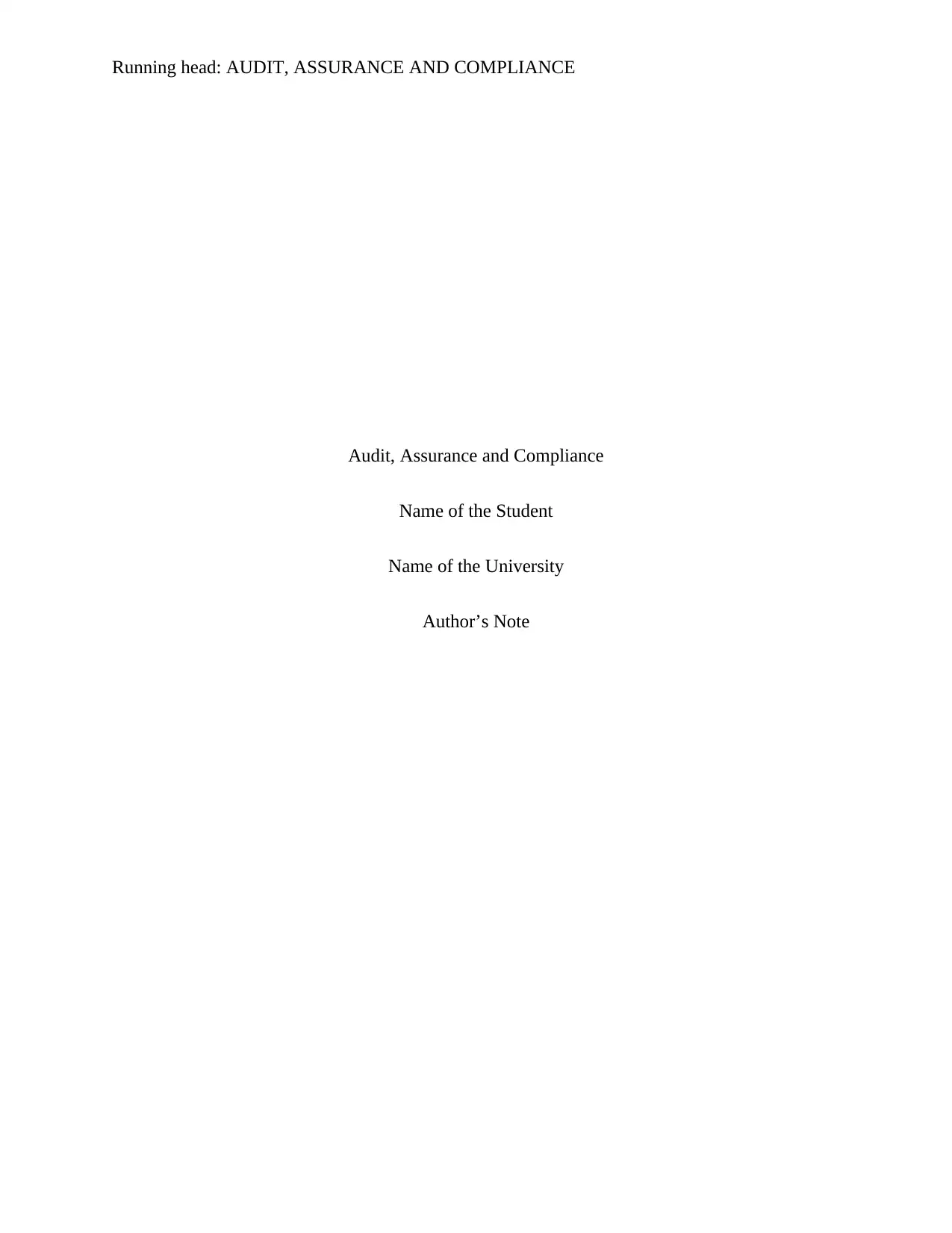
Running head: AUDIT, ASSURANCE AND COMPLIANCE
Audit, Assurance and Compliance
Name of the Student
Name of the University
Author’s Note
Audit, Assurance and Compliance
Name of the Student
Name of the University
Author’s Note
Paraphrase This Document
Need a fresh take? Get an instant paraphrase of this document with our AI Paraphraser
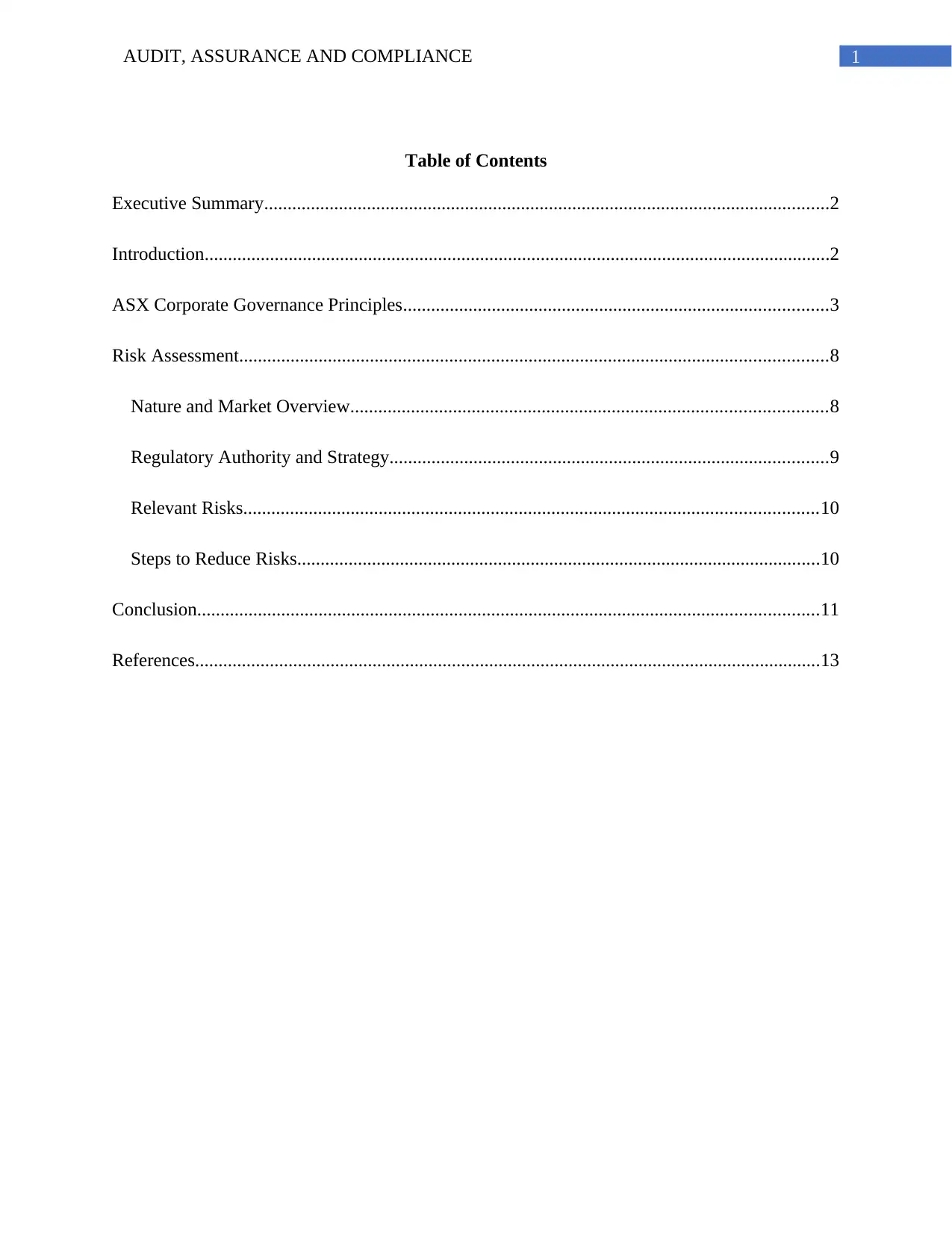
1AUDIT, ASSURANCE AND COMPLIANCE
Table of Contents
Executive Summary.........................................................................................................................2
Introduction......................................................................................................................................2
ASX Corporate Governance Principles...........................................................................................3
Risk Assessment..............................................................................................................................8
Nature and Market Overview......................................................................................................8
Regulatory Authority and Strategy..............................................................................................9
Relevant Risks...........................................................................................................................10
Steps to Reduce Risks................................................................................................................10
Conclusion.....................................................................................................................................11
References......................................................................................................................................13
Table of Contents
Executive Summary.........................................................................................................................2
Introduction......................................................................................................................................2
ASX Corporate Governance Principles...........................................................................................3
Risk Assessment..............................................................................................................................8
Nature and Market Overview......................................................................................................8
Regulatory Authority and Strategy..............................................................................................9
Relevant Risks...........................................................................................................................10
Steps to Reduce Risks................................................................................................................10
Conclusion.....................................................................................................................................11
References......................................................................................................................................13
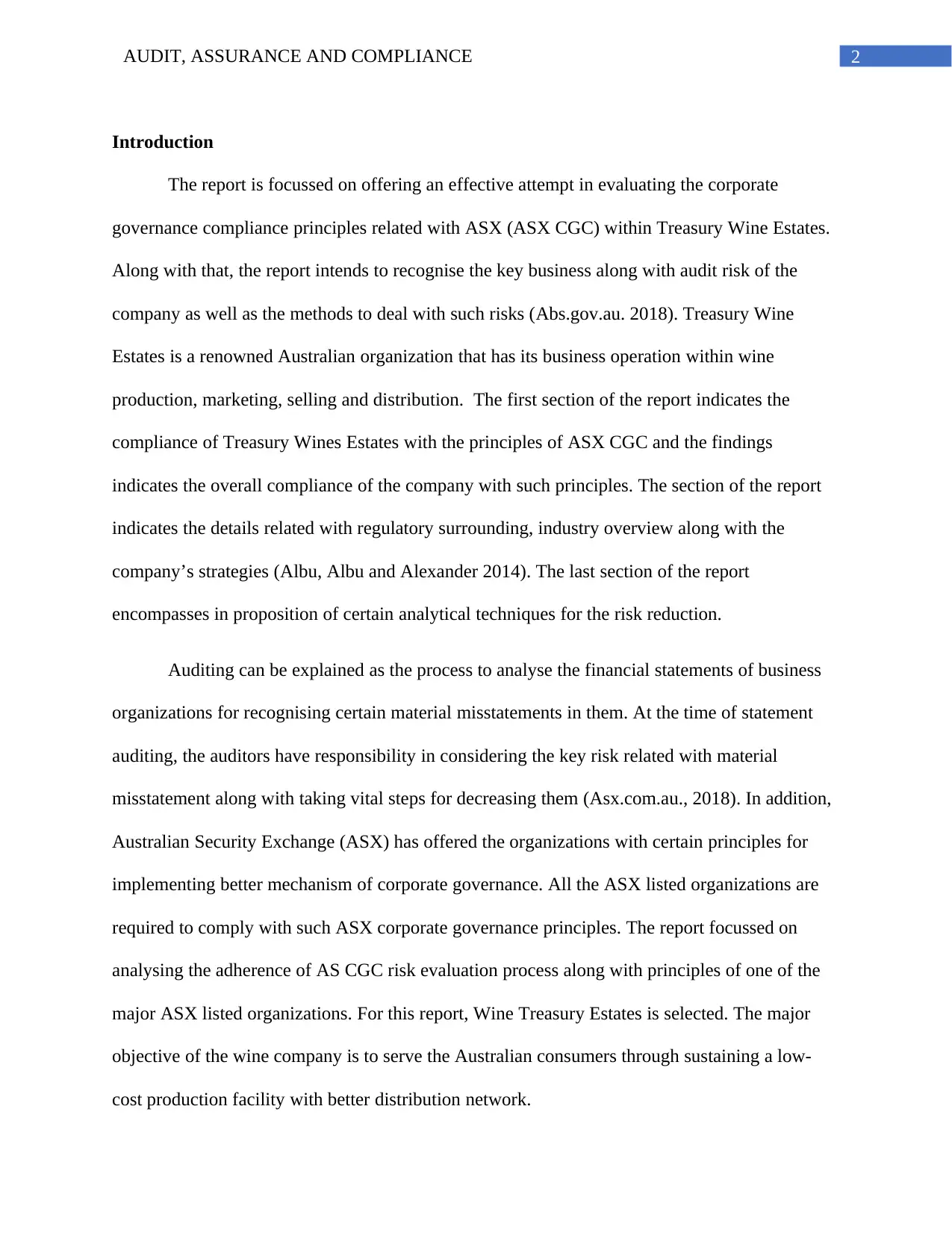
2AUDIT, ASSURANCE AND COMPLIANCE
Introduction
The report is focussed on offering an effective attempt in evaluating the corporate
governance compliance principles related with ASX (ASX CGC) within Treasury Wine Estates.
Along with that, the report intends to recognise the key business along with audit risk of the
company as well as the methods to deal with such risks (Abs.gov.au. 2018). Treasury Wine
Estates is a renowned Australian organization that has its business operation within wine
production, marketing, selling and distribution. The first section of the report indicates the
compliance of Treasury Wines Estates with the principles of ASX CGC and the findings
indicates the overall compliance of the company with such principles. The section of the report
indicates the details related with regulatory surrounding, industry overview along with the
company’s strategies (Albu, Albu and Alexander 2014). The last section of the report
encompasses in proposition of certain analytical techniques for the risk reduction.
Auditing can be explained as the process to analyse the financial statements of business
organizations for recognising certain material misstatements in them. At the time of statement
auditing, the auditors have responsibility in considering the key risk related with material
misstatement along with taking vital steps for decreasing them (Asx.com.au., 2018). In addition,
Australian Security Exchange (ASX) has offered the organizations with certain principles for
implementing better mechanism of corporate governance. All the ASX listed organizations are
required to comply with such ASX corporate governance principles. The report focussed on
analysing the adherence of AS CGC risk evaluation process along with principles of one of the
major ASX listed organizations. For this report, Wine Treasury Estates is selected. The major
objective of the wine company is to serve the Australian consumers through sustaining a low-
cost production facility with better distribution network.
Introduction
The report is focussed on offering an effective attempt in evaluating the corporate
governance compliance principles related with ASX (ASX CGC) within Treasury Wine Estates.
Along with that, the report intends to recognise the key business along with audit risk of the
company as well as the methods to deal with such risks (Abs.gov.au. 2018). Treasury Wine
Estates is a renowned Australian organization that has its business operation within wine
production, marketing, selling and distribution. The first section of the report indicates the
compliance of Treasury Wines Estates with the principles of ASX CGC and the findings
indicates the overall compliance of the company with such principles. The section of the report
indicates the details related with regulatory surrounding, industry overview along with the
company’s strategies (Albu, Albu and Alexander 2014). The last section of the report
encompasses in proposition of certain analytical techniques for the risk reduction.
Auditing can be explained as the process to analyse the financial statements of business
organizations for recognising certain material misstatements in them. At the time of statement
auditing, the auditors have responsibility in considering the key risk related with material
misstatement along with taking vital steps for decreasing them (Asx.com.au., 2018). In addition,
Australian Security Exchange (ASX) has offered the organizations with certain principles for
implementing better mechanism of corporate governance. All the ASX listed organizations are
required to comply with such ASX corporate governance principles. The report focussed on
analysing the adherence of AS CGC risk evaluation process along with principles of one of the
major ASX listed organizations. For this report, Wine Treasury Estates is selected. The major
objective of the wine company is to serve the Australian consumers through sustaining a low-
cost production facility with better distribution network.
⊘ This is a preview!⊘
Do you want full access?
Subscribe today to unlock all pages.

Trusted by 1+ million students worldwide
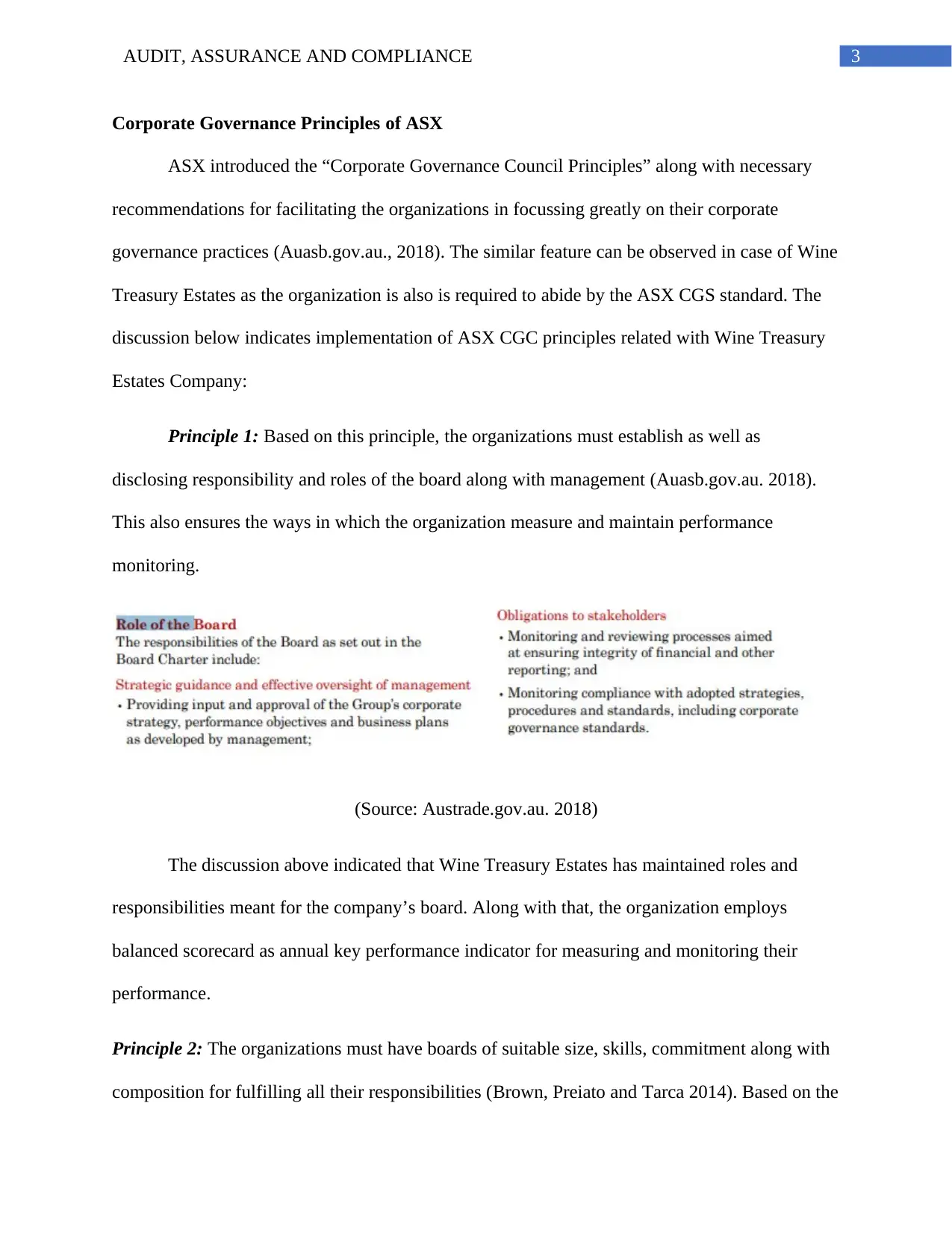
3AUDIT, ASSURANCE AND COMPLIANCE
Corporate Governance Principles of ASX
ASX introduced the “Corporate Governance Council Principles” along with necessary
recommendations for facilitating the organizations in focussing greatly on their corporate
governance practices (Auasb.gov.au., 2018). The similar feature can be observed in case of Wine
Treasury Estates as the organization is also is required to abide by the ASX CGS standard. The
discussion below indicates implementation of ASX CGC principles related with Wine Treasury
Estates Company:
Principle 1: Based on this principle, the organizations must establish as well as
disclosing responsibility and roles of the board along with management (Auasb.gov.au. 2018).
This also ensures the ways in which the organization measure and maintain performance
monitoring.
(Source: Austrade.gov.au. 2018)
The discussion above indicated that Wine Treasury Estates has maintained roles and
responsibilities meant for the company’s board. Along with that, the organization employs
balanced scorecard as annual key performance indicator for measuring and monitoring their
performance.
Principle 2: The organizations must have boards of suitable size, skills, commitment along with
composition for fulfilling all their responsibilities (Brown, Preiato and Tarca 2014). Based on the
Corporate Governance Principles of ASX
ASX introduced the “Corporate Governance Council Principles” along with necessary
recommendations for facilitating the organizations in focussing greatly on their corporate
governance practices (Auasb.gov.au., 2018). The similar feature can be observed in case of Wine
Treasury Estates as the organization is also is required to abide by the ASX CGS standard. The
discussion below indicates implementation of ASX CGC principles related with Wine Treasury
Estates Company:
Principle 1: Based on this principle, the organizations must establish as well as
disclosing responsibility and roles of the board along with management (Auasb.gov.au. 2018).
This also ensures the ways in which the organization measure and maintain performance
monitoring.
(Source: Austrade.gov.au. 2018)
The discussion above indicated that Wine Treasury Estates has maintained roles and
responsibilities meant for the company’s board. Along with that, the organization employs
balanced scorecard as annual key performance indicator for measuring and monitoring their
performance.
Principle 2: The organizations must have boards of suitable size, skills, commitment along with
composition for fulfilling all their responsibilities (Brown, Preiato and Tarca 2014). Based on the
Paraphrase This Document
Need a fresh take? Get an instant paraphrase of this document with our AI Paraphraser
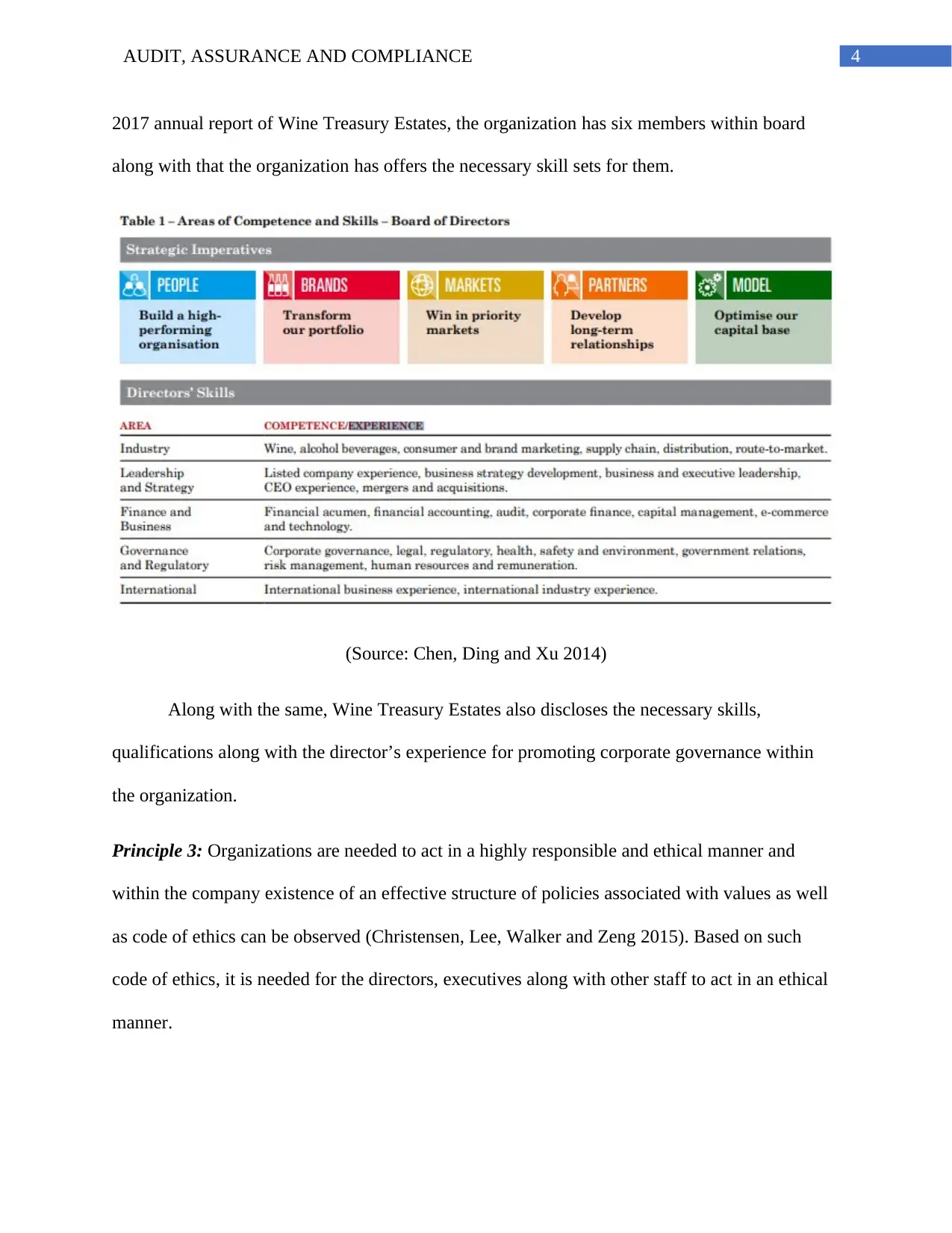
4AUDIT, ASSURANCE AND COMPLIANCE
2017 annual report of Wine Treasury Estates, the organization has six members within board
along with that the organization has offers the necessary skill sets for them.
(Source: Chen, Ding and Xu 2014)
Along with the same, Wine Treasury Estates also discloses the necessary skills,
qualifications along with the director’s experience for promoting corporate governance within
the organization.
Principle 3: Organizations are needed to act in a highly responsible and ethical manner and
within the company existence of an effective structure of policies associated with values as well
as code of ethics can be observed (Christensen, Lee, Walker and Zeng 2015). Based on such
code of ethics, it is needed for the directors, executives along with other staff to act in an ethical
manner.
2017 annual report of Wine Treasury Estates, the organization has six members within board
along with that the organization has offers the necessary skill sets for them.
(Source: Chen, Ding and Xu 2014)
Along with the same, Wine Treasury Estates also discloses the necessary skills,
qualifications along with the director’s experience for promoting corporate governance within
the organization.
Principle 3: Organizations are needed to act in a highly responsible and ethical manner and
within the company existence of an effective structure of policies associated with values as well
as code of ethics can be observed (Christensen, Lee, Walker and Zeng 2015). Based on such
code of ethics, it is needed for the directors, executives along with other staff to act in an ethical
manner.
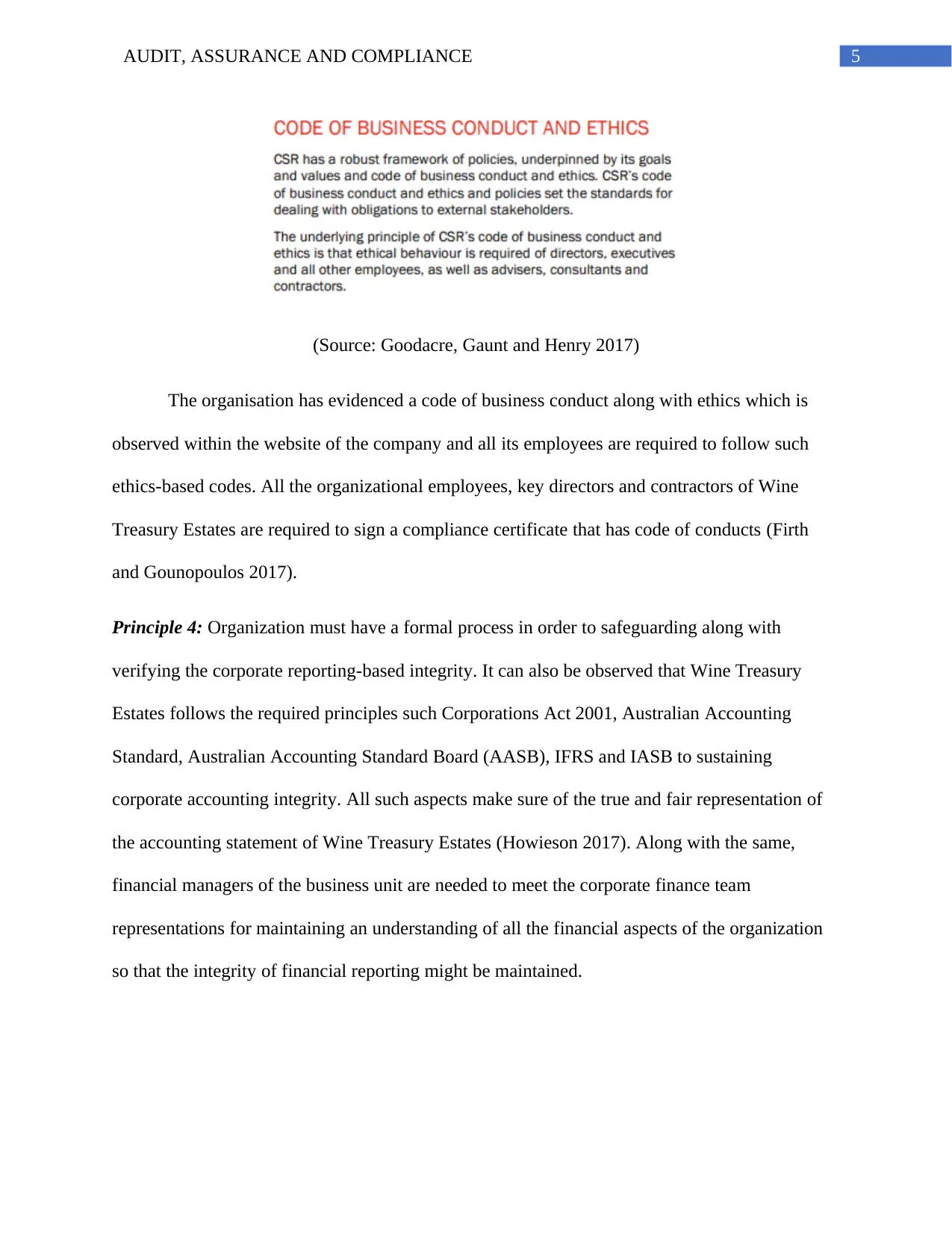
5AUDIT, ASSURANCE AND COMPLIANCE
(Source: Goodacre, Gaunt and Henry 2017)
The organisation has evidenced a code of business conduct along with ethics which is
observed within the website of the company and all its employees are required to follow such
ethics-based codes. All the organizational employees, key directors and contractors of Wine
Treasury Estates are required to sign a compliance certificate that has code of conducts (Firth
and Gounopoulos 2017).
Principle 4: Organization must have a formal process in order to safeguarding along with
verifying the corporate reporting-based integrity. It can also be observed that Wine Treasury
Estates follows the required principles such Corporations Act 2001, Australian Accounting
Standard, Australian Accounting Standard Board (AASB), IFRS and IASB to sustaining
corporate accounting integrity. All such aspects make sure of the true and fair representation of
the accounting statement of Wine Treasury Estates (Howieson 2017). Along with the same,
financial managers of the business unit are needed to meet the corporate finance team
representations for maintaining an understanding of all the financial aspects of the organization
so that the integrity of financial reporting might be maintained.
(Source: Goodacre, Gaunt and Henry 2017)
The organisation has evidenced a code of business conduct along with ethics which is
observed within the website of the company and all its employees are required to follow such
ethics-based codes. All the organizational employees, key directors and contractors of Wine
Treasury Estates are required to sign a compliance certificate that has code of conducts (Firth
and Gounopoulos 2017).
Principle 4: Organization must have a formal process in order to safeguarding along with
verifying the corporate reporting-based integrity. It can also be observed that Wine Treasury
Estates follows the required principles such Corporations Act 2001, Australian Accounting
Standard, Australian Accounting Standard Board (AASB), IFRS and IASB to sustaining
corporate accounting integrity. All such aspects make sure of the true and fair representation of
the accounting statement of Wine Treasury Estates (Howieson 2017). Along with the same,
financial managers of the business unit are needed to meet the corporate finance team
representations for maintaining an understanding of all the financial aspects of the organization
so that the integrity of financial reporting might be maintained.
⊘ This is a preview!⊘
Do you want full access?
Subscribe today to unlock all pages.

Trusted by 1+ million students worldwide
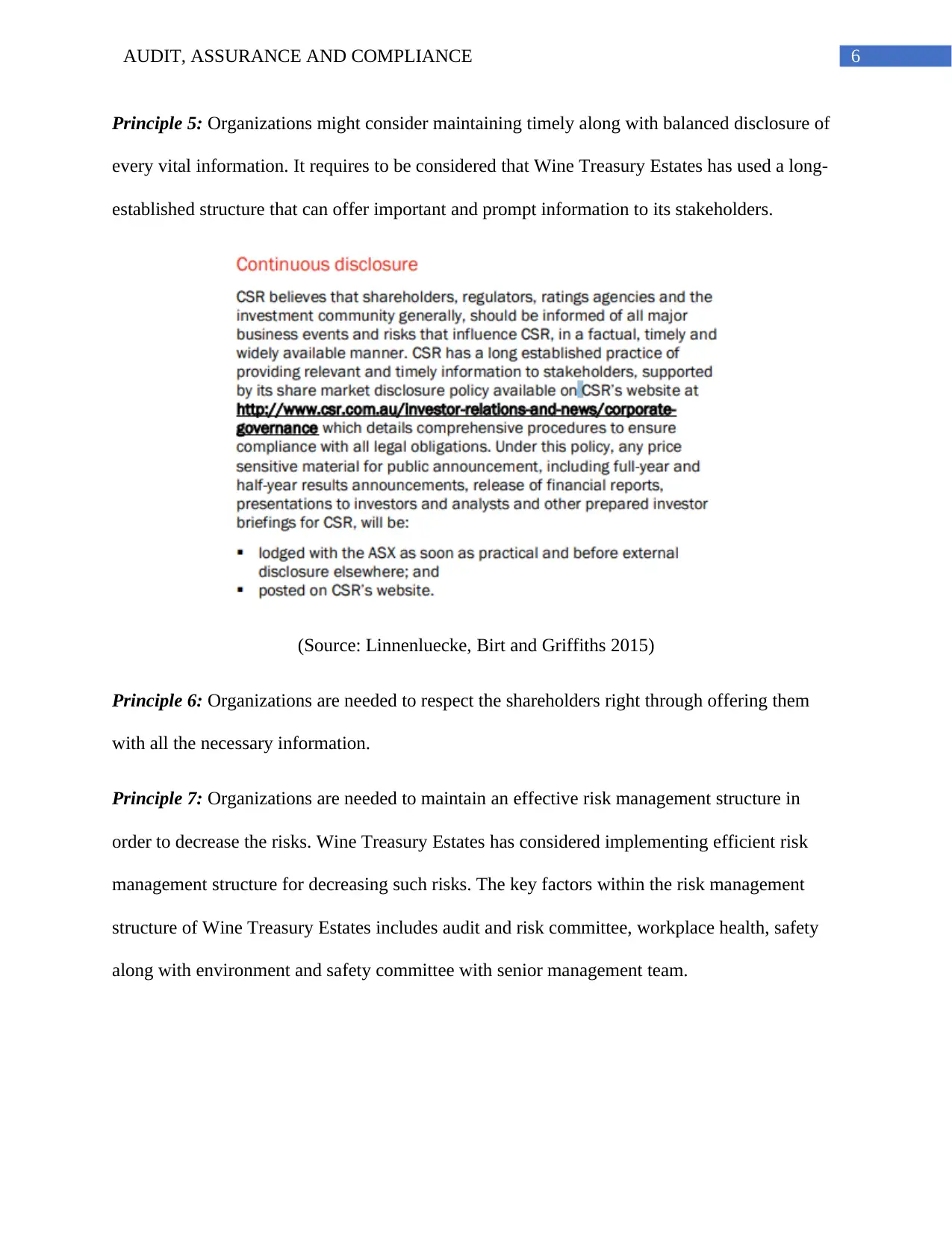
6AUDIT, ASSURANCE AND COMPLIANCE
Principle 5: Organizations might consider maintaining timely along with balanced disclosure of
every vital information. It requires to be considered that Wine Treasury Estates has used a long-
established structure that can offer important and prompt information to its stakeholders.
(Source: Linnenluecke, Birt and Griffiths 2015)
Principle 6: Organizations are needed to respect the shareholders right through offering them
with all the necessary information.
Principle 7: Organizations are needed to maintain an effective risk management structure in
order to decrease the risks. Wine Treasury Estates has considered implementing efficient risk
management structure for decreasing such risks. The key factors within the risk management
structure of Wine Treasury Estates includes audit and risk committee, workplace health, safety
along with environment and safety committee with senior management team.
Principle 5: Organizations might consider maintaining timely along with balanced disclosure of
every vital information. It requires to be considered that Wine Treasury Estates has used a long-
established structure that can offer important and prompt information to its stakeholders.
(Source: Linnenluecke, Birt and Griffiths 2015)
Principle 6: Organizations are needed to respect the shareholders right through offering them
with all the necessary information.
Principle 7: Organizations are needed to maintain an effective risk management structure in
order to decrease the risks. Wine Treasury Estates has considered implementing efficient risk
management structure for decreasing such risks. The key factors within the risk management
structure of Wine Treasury Estates includes audit and risk committee, workplace health, safety
along with environment and safety committee with senior management team.
Paraphrase This Document
Need a fresh take? Get an instant paraphrase of this document with our AI Paraphraser
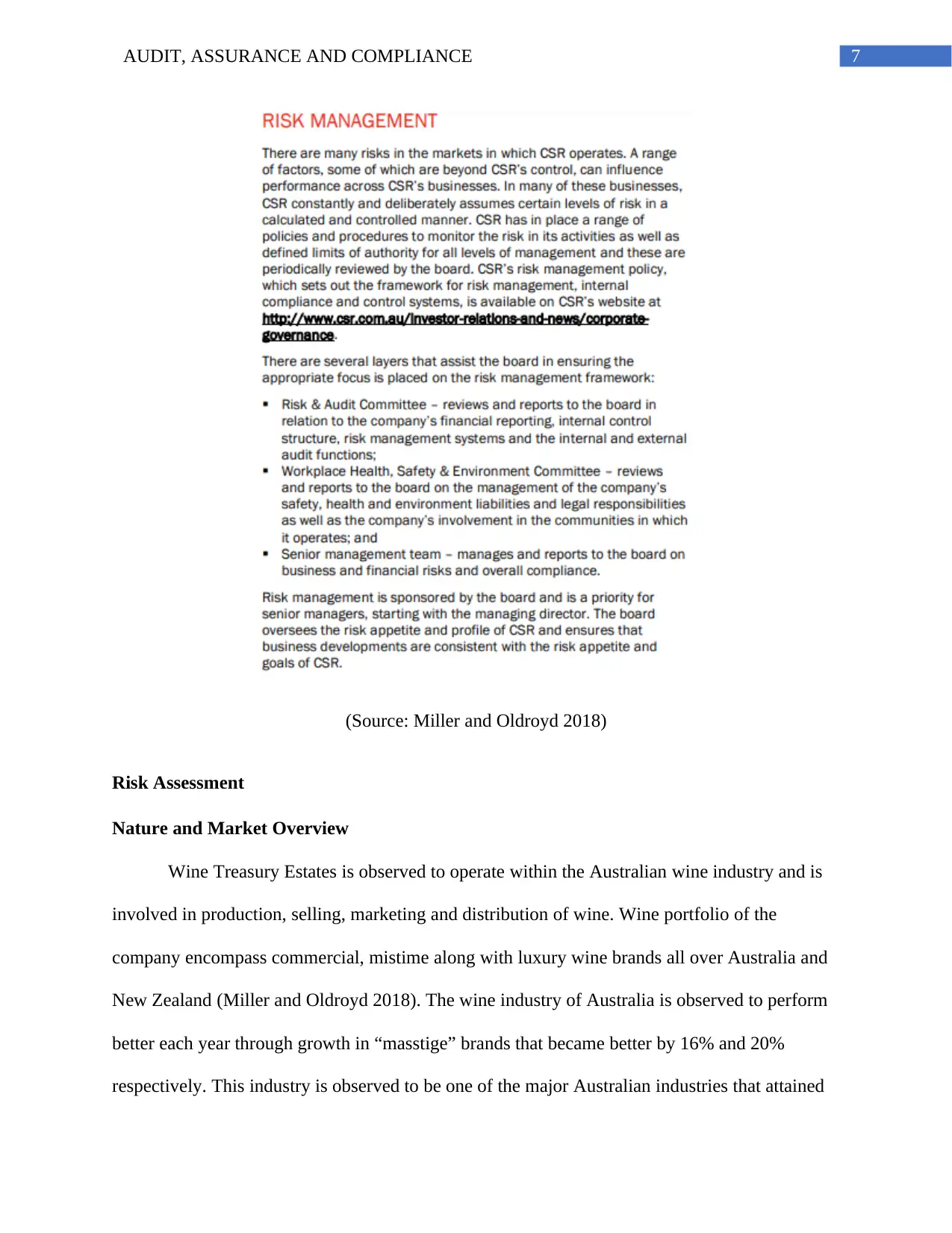
7AUDIT, ASSURANCE AND COMPLIANCE
(Source: Miller and Oldroyd 2018)
Risk Assessment
Nature and Market Overview
Wine Treasury Estates is observed to operate within the Australian wine industry and is
involved in production, selling, marketing and distribution of wine. Wine portfolio of the
company encompass commercial, mistime along with luxury wine brands all over Australia and
New Zealand (Miller and Oldroyd 2018). The wine industry of Australia is observed to perform
better each year through growth in “masstige” brands that became better by 16% and 20%
respectively. This industry is observed to be one of the major Australian industries that attained
(Source: Miller and Oldroyd 2018)
Risk Assessment
Nature and Market Overview
Wine Treasury Estates is observed to operate within the Australian wine industry and is
involved in production, selling, marketing and distribution of wine. Wine portfolio of the
company encompass commercial, mistime along with luxury wine brands all over Australia and
New Zealand (Miller and Oldroyd 2018). The wine industry of Australia is observed to perform
better each year through growth in “masstige” brands that became better by 16% and 20%
respectively. This industry is observed to be one of the major Australian industries that attained
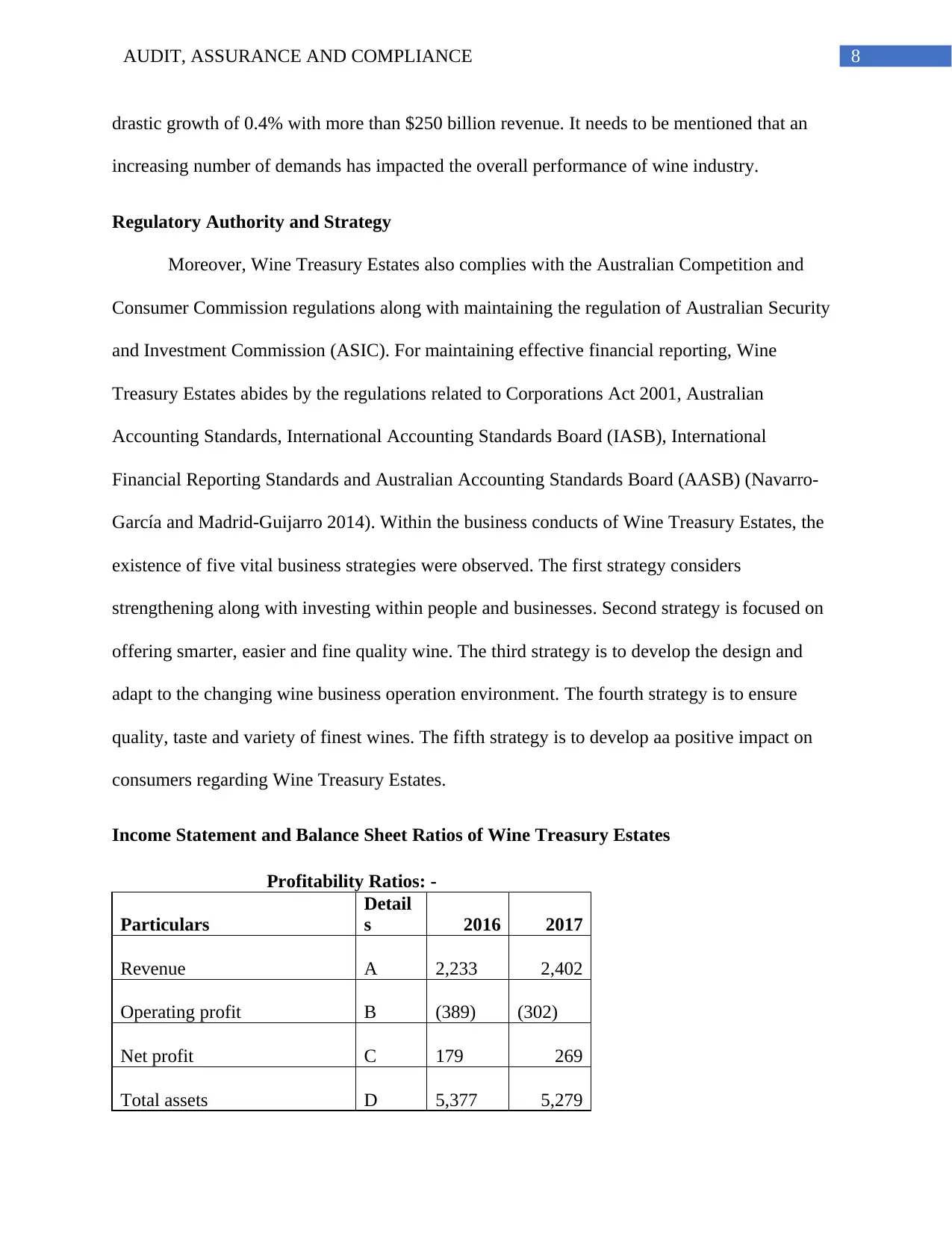
8AUDIT, ASSURANCE AND COMPLIANCE
drastic growth of 0.4% with more than $250 billion revenue. It needs to be mentioned that an
increasing number of demands has impacted the overall performance of wine industry.
Regulatory Authority and Strategy
Moreover, Wine Treasury Estates also complies with the Australian Competition and
Consumer Commission regulations along with maintaining the regulation of Australian Security
and Investment Commission (ASIC). For maintaining effective financial reporting, Wine
Treasury Estates abides by the regulations related to Corporations Act 2001, Australian
Accounting Standards, International Accounting Standards Board (IASB), International
Financial Reporting Standards and Australian Accounting Standards Board (AASB) (Navarro‐
García and Madrid‐Guijarro 2014). Within the business conducts of Wine Treasury Estates, the
existence of five vital business strategies were observed. The first strategy considers
strengthening along with investing within people and businesses. Second strategy is focused on
offering smarter, easier and fine quality wine. The third strategy is to develop the design and
adapt to the changing wine business operation environment. The fourth strategy is to ensure
quality, taste and variety of finest wines. The fifth strategy is to develop aa positive impact on
consumers regarding Wine Treasury Estates.
Income Statement and Balance Sheet Ratios of Wine Treasury Estates
Profitability Ratios: -
Particulars
Detail
s 2016 2017
Revenue A 2,233 2,402
Operating profit B (389) (302)
Net profit C 179 269
Total assets D 5,377 5,279
drastic growth of 0.4% with more than $250 billion revenue. It needs to be mentioned that an
increasing number of demands has impacted the overall performance of wine industry.
Regulatory Authority and Strategy
Moreover, Wine Treasury Estates also complies with the Australian Competition and
Consumer Commission regulations along with maintaining the regulation of Australian Security
and Investment Commission (ASIC). For maintaining effective financial reporting, Wine
Treasury Estates abides by the regulations related to Corporations Act 2001, Australian
Accounting Standards, International Accounting Standards Board (IASB), International
Financial Reporting Standards and Australian Accounting Standards Board (AASB) (Navarro‐
García and Madrid‐Guijarro 2014). Within the business conducts of Wine Treasury Estates, the
existence of five vital business strategies were observed. The first strategy considers
strengthening along with investing within people and businesses. Second strategy is focused on
offering smarter, easier and fine quality wine. The third strategy is to develop the design and
adapt to the changing wine business operation environment. The fourth strategy is to ensure
quality, taste and variety of finest wines. The fifth strategy is to develop aa positive impact on
consumers regarding Wine Treasury Estates.
Income Statement and Balance Sheet Ratios of Wine Treasury Estates
Profitability Ratios: -
Particulars
Detail
s 2016 2017
Revenue A 2,233 2,402
Operating profit B (389) (302)
Net profit C 179 269
Total assets D 5,377 5,279
⊘ This is a preview!⊘
Do you want full access?
Subscribe today to unlock all pages.

Trusted by 1+ million students worldwide
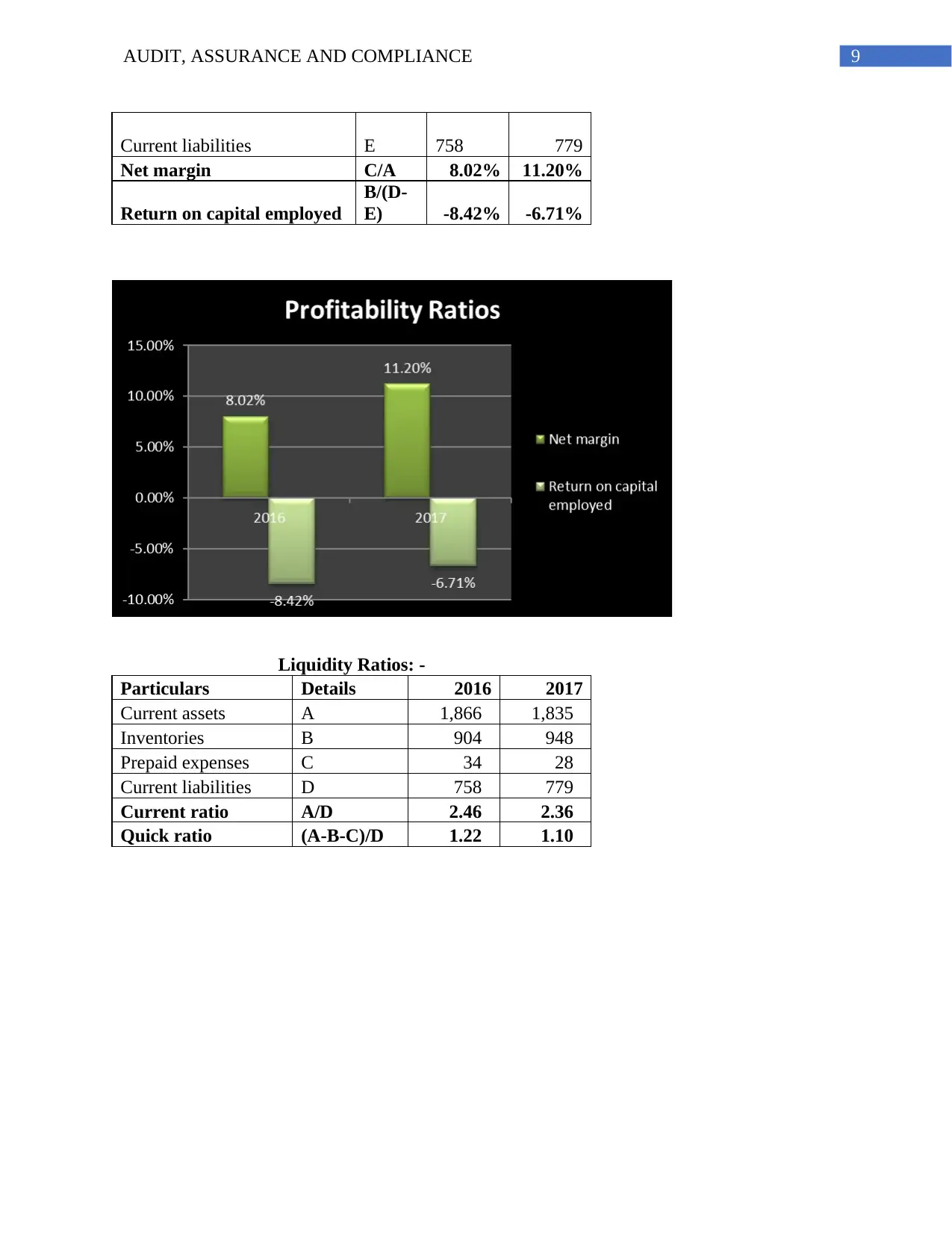
9AUDIT, ASSURANCE AND COMPLIANCE
Current liabilities E 758 779
Net margin C/A 8.02% 11.20%
Return on capital employed
B/(D-
E) -8.42% -6.71%
Liquidity Ratios: -
Particulars Details 2016 2017
Current assets A 1,866 1,835
Inventories B 904 948
Prepaid expenses C 34 28
Current liabilities D 758 779
Current ratio A/D 2.46 2.36
Quick ratio (A-B-C)/D 1.22 1.10
Current liabilities E 758 779
Net margin C/A 8.02% 11.20%
Return on capital employed
B/(D-
E) -8.42% -6.71%
Liquidity Ratios: -
Particulars Details 2016 2017
Current assets A 1,866 1,835
Inventories B 904 948
Prepaid expenses C 34 28
Current liabilities D 758 779
Current ratio A/D 2.46 2.36
Quick ratio (A-B-C)/D 1.22 1.10
Paraphrase This Document
Need a fresh take? Get an instant paraphrase of this document with our AI Paraphraser
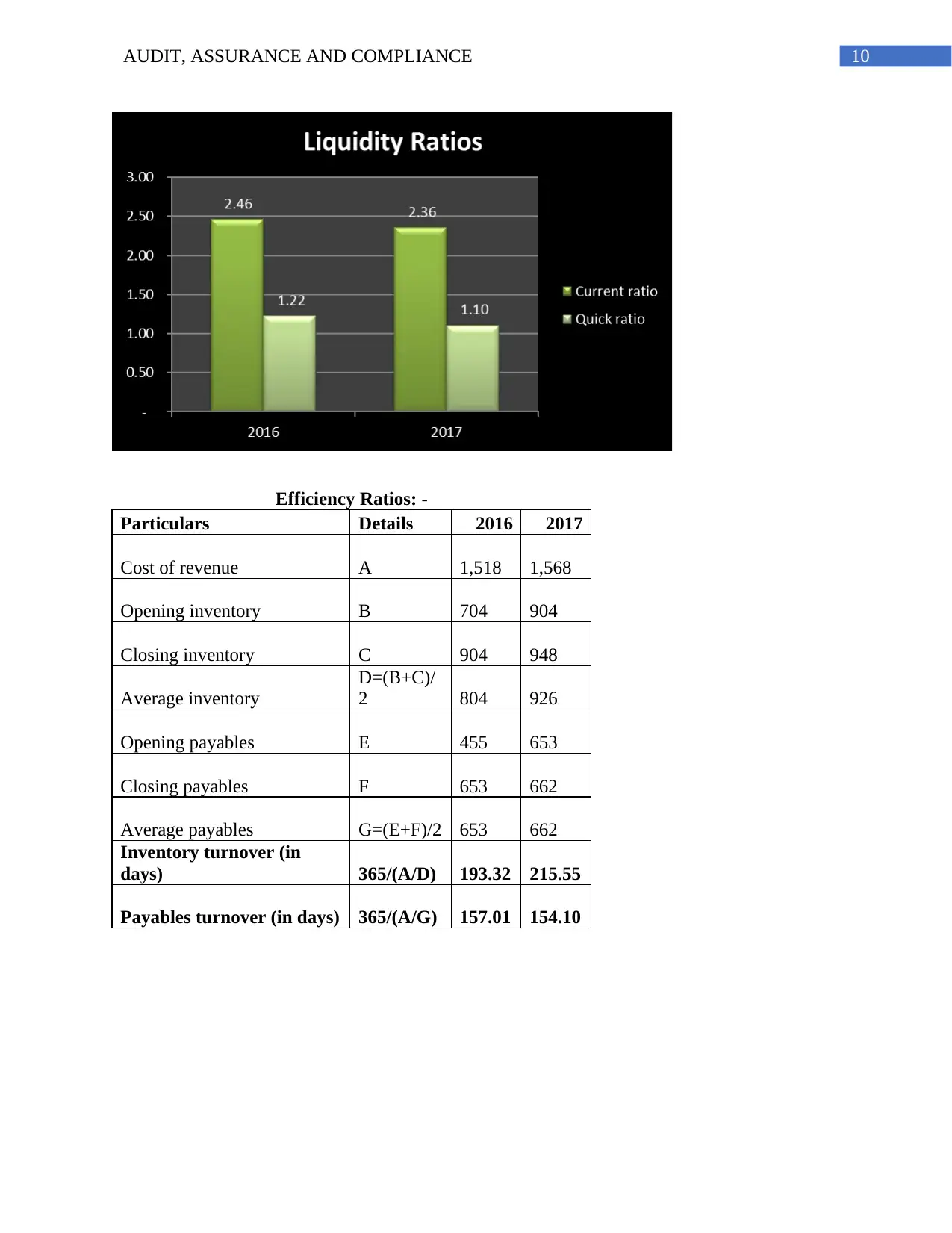
10AUDIT, ASSURANCE AND COMPLIANCE
Efficiency Ratios: -
Particulars Details 2016 2017
Cost of revenue A 1,518 1,568
Opening inventory B 704 904
Closing inventory C 904 948
Average inventory
D=(B+C)/
2 804 926
Opening payables E 455 653
Closing payables F 653 662
Average payables G=(E+F)/2 653 662
Inventory turnover (in
days) 365/(A/D) 193.32 215.55
Payables turnover (in days) 365/(A/G) 157.01 154.10
Efficiency Ratios: -
Particulars Details 2016 2017
Cost of revenue A 1,518 1,568
Opening inventory B 704 904
Closing inventory C 904 948
Average inventory
D=(B+C)/
2 804 926
Opening payables E 455 653
Closing payables F 653 662
Average payables G=(E+F)/2 653 662
Inventory turnover (in
days) 365/(A/D) 193.32 215.55
Payables turnover (in days) 365/(A/G) 157.01 154.10
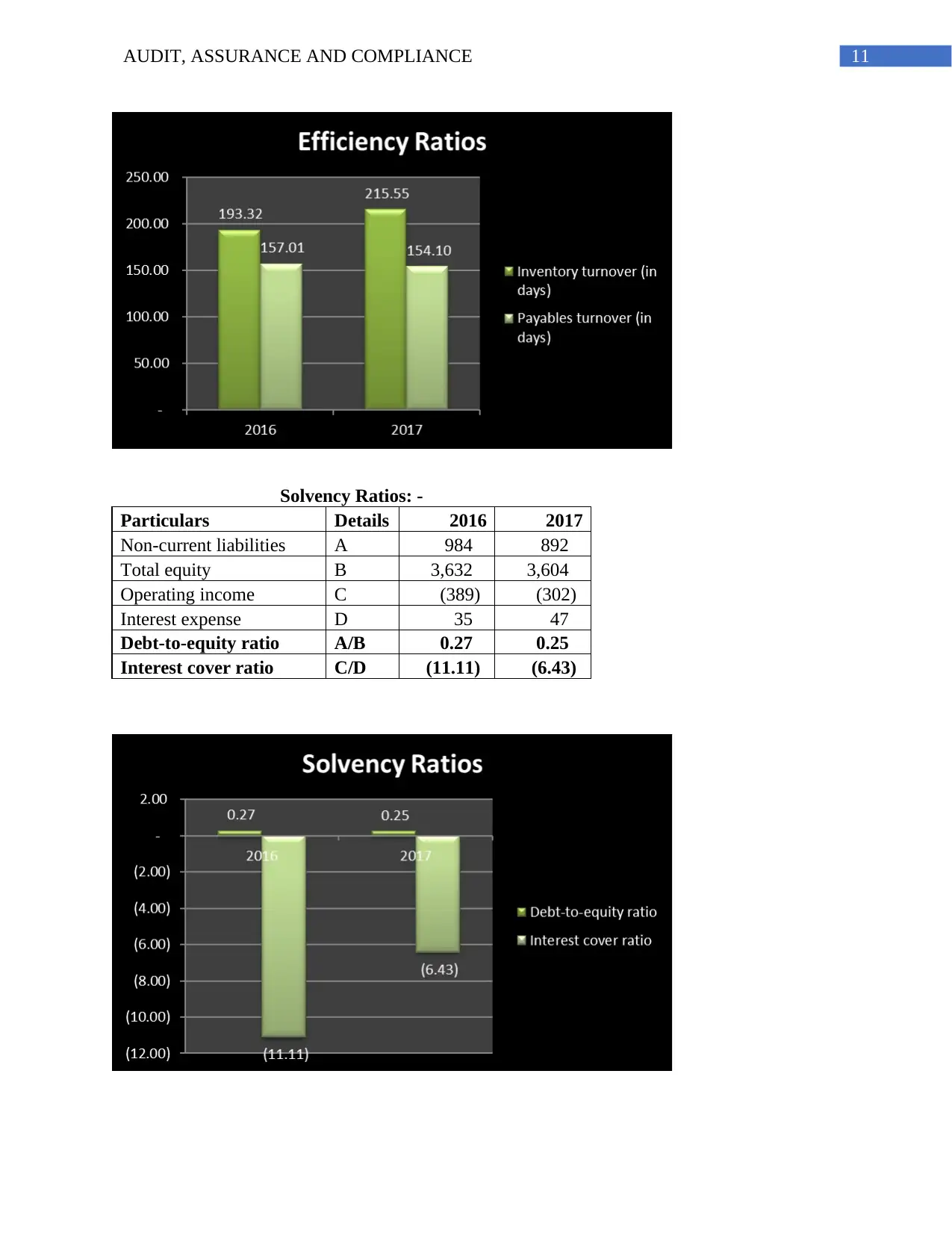
11AUDIT, ASSURANCE AND COMPLIANCE
Solvency Ratios: -
Particulars Details 2016 2017
Non-current liabilities A 984 892
Total equity B 3,632 3,604
Operating income C (389) (302)
Interest expense D 35 47
Debt-to-equity ratio A/B 0.27 0.25
Interest cover ratio C/D (11.11) (6.43)
Solvency Ratios: -
Particulars Details 2016 2017
Non-current liabilities A 984 892
Total equity B 3,632 3,604
Operating income C (389) (302)
Interest expense D 35 47
Debt-to-equity ratio A/B 0.27 0.25
Interest cover ratio C/D (11.11) (6.43)
⊘ This is a preview!⊘
Do you want full access?
Subscribe today to unlock all pages.

Trusted by 1+ million students worldwide
1 out of 20
Related Documents
Your All-in-One AI-Powered Toolkit for Academic Success.
+13062052269
info@desklib.com
Available 24*7 on WhatsApp / Email
![[object Object]](/_next/static/media/star-bottom.7253800d.svg)
Unlock your academic potential
Copyright © 2020–2025 A2Z Services. All Rights Reserved. Developed and managed by ZUCOL.




